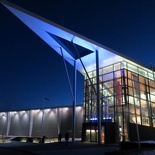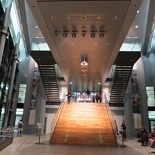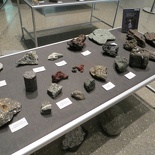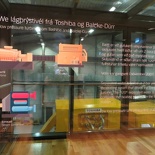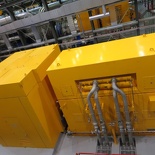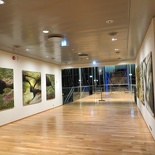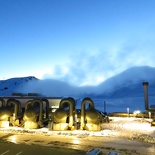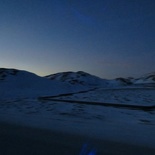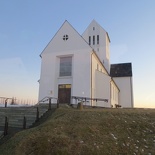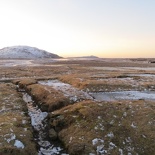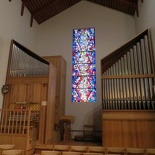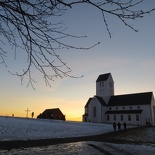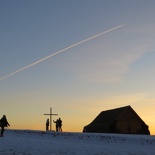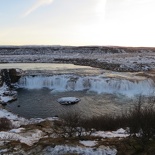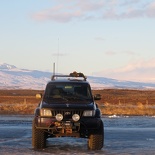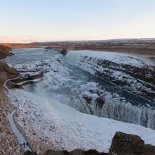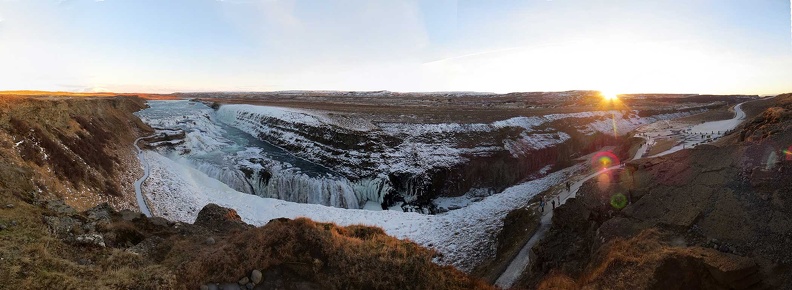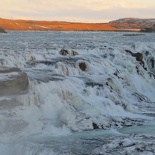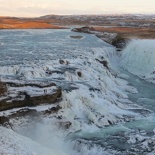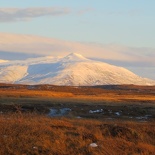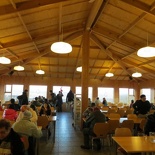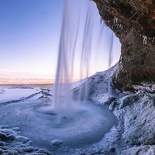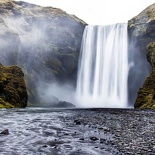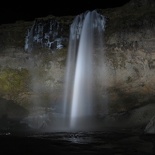The Icelandic Golden Circle is one of the few known routes in Iceland which brings you the best of nature along a looping circular road covering half the Icelandic island, therefore its name the Route 1 Ring road. Many of the attractions are a stone throw away from the city of Reykjavik, situated south of the Icelandic island. After a short 40 minute drive off the city of Reykjavik, you will be able to visit one of Iceland’s few geothermal power plants located south west in Iceland.
Hellisheiði geothermal plant
Being a volcanic active area, geothermal power is a very viable power generation option on the remote island with not much natural resources. This provides for a continuous and reliable clean supply of electricity, as well as providing piped heated water for household heating in the winter for Reykjavik city without the need for the burning of fossil fuels.
The exterior of the geothermal plant building is large and modern, with a flair of clean architecture sitting out of a sea of white tundra. The front of the power plant sits the visitor center and main public entrance- a show piece with a long triangular super structure sticking out like a piece of modern art. The modern design carries into the lobby interior with its glass and wood cladding.
Notably, the power station also spots its own souvenir store (tourist attraction reasons), as well as a mini museum. Items on display here include various drilling tools, like the ones used for boring holes into the ground where the geothermal steam can be extracted.
The power station spots a number of educational exhibits and display panels lined along the galleries within the facility spanning two floors. It is an Energy Exhibition showcase of benefits of geothermal power. A guided tour of the area will set you back 500 ISK per person. We were brought around for a tour of the plant with its various sections lined with interactive touch-screen boards, before being brought to observe main generator room.
This single-floored hangar-like structure houses the equipment to pipe the superheated (flash) steam. This is sent through spinning turbines and generators which generate electricity. The hot steam also has the extracted heat exchanged via heat exchangers to piped hot water, which is pumped for purposes of central heating.
Panorama of the Hellisheidi geothermal power plant generator room.
The Hellisheiði geothermal plant is a flash steam, combined heat and power plant and one of the largest wet high-enthalpy, geothermal systems in the region. It has a total output up to 400MWth achieved by extracting heated water through 50 separate underground bore holes drilled up to a depth of 2km deep within the earth’s crust. The prevalence of volcanic activity here means most of the geothermal hotspots are near the surface of the earth’s crust.
Therefore, a 2km depth is not too deep compared to other geothermal plants non-volcanic active regions. The geothermal heat here spins turbines which supplies much of Reykjavik with electricity and up to 40% of Iceland’s total power, with other geothermal plants, solar and localized power generation catering for the remaining power demand.
There is a small lingering smell of sulphur in the power plant, a by-product of the flash steam extracted from the subterranean geothermal springs, reminding you much of the deep and potentially dangerous geothermal activities which goes on here. Besides electricity, heat extracted by the plant also provides a reliable source of hot water used for the heating of buildings. You can see these properly-lagged long-distance transmission pipes tunneling through the mountains in the open tundra from the station towards Reykjavik on the Icelandic highways.
Skálholt church
With the first sunrise of the day, is my next stop is Skálholt church. Skálholt is one of the most historic places in Iceland and one of Iceland’s oldest churches still standing. Since its initial construction more than 700 years ago, it saw use as a venue of episcopal authority, a school, a place of learning, administration and pilgrimage in medieval times.
The church however, being rebuilt over 11 times on the same hill, it was several construction and upgrade phrases throughout its lifetime. A new cathedral extension was built from 1956 to 1963 as a part of the upgrades to prepare the church for the new millennial. The present Cathedral building still standing today is a little more modern, being consecrated in 1963 and is the 10th church standing on exactly the same site. Much of the Cathedral past can be seen through the array preserved excavation structures situated around the church building, showing the old foundations of the buildings which once stood here.
Panorama of Skálholt church Interior.
Inside the Cathedral, the main hall is clad in white with rows of benches where services are held. Besides services every Sunday, there are morning and evening prayers on weekdays. It is open for all. The interior is decorated with valuable art, both old and new. The Cathedral also houses a crypt featuring a small exhibition from the National Museum with items excavated from the site itself.
Panorama of the grounds surrounding Skálholt church.
The Icelandic people claim that Skálholt is a symbol more than a site of historical significance, adding that it is a place of culture, spirituality and music run by the Evangelical Lutheran Church of Iceland. It is the site of a deputy bishop and a local parish pastor. As history speaks, is also the very church where the last the last bishop of Iceland was beheaded during the Christian revolution.
Despite seemingly situated in the middle of nowhere, Skálholt is also a site of gathering frequent cultural, educational and artistic events and retreats. The landscape surrounding the Church and cathedral is open, chill and tranquil, with an absence of any nearby human life or vehicles. I got some good sights of the Godafoss waterfall. The sky was clear on the day of my visit offering unobstructed views of high altitude cloud with an occasional jet stream. Tonight might be a good night to see the Northern lights too.
Gullfoss waterfall
Following on the Golden circle route is the famous Gullfoss waterfall. Gullfoss is one of Iceland’s most iconic and picturesque falls located in the South of Iceland on the Hvítá (White) river. It is a fantastic huge tiered, cataract waterfall located along the flow path of the said Hvítá River. The water feeding the falls begins at the Hvitarvatn glacier lake, where it is fed by Iceland´s second biggest glacier, the Langjökull. The fresh fast moving glacier water flows southward for 40km to this spot.
Gullfoss stands for Golden Waterfall in Icelandic, namely due to the golden colour of the water as it centers the final plunge pool. It is one of the main must-see sights of beauty as part of the Golden Circle tour offering spectaculars view of the forces and beauty of untouched nature.
Despite being partially frozen in winter, a sizable amount of glacier water still flows fast from the upper river, meaning that the waterfall can be visited all year round, with the peak of spring being offering the strongest flow. Surrounding the waterfall is a rugged golden canyon with walls reaching up to 70 meters in height on both sides of the waterfall.
Panorama of Icelandic Gullfoss waterfall
The fast flowing Hvítá expands to about a kilometer wide stream as it approaches the falls. The flow then turns abruptly to right, followed by zig-zagging as it dumps water over a mini gorge, before cascading down three distinctive stepped staircase surfaces. The waterfall then abruptly plummets 32 meters down in two stages, giving the water its unique cascading plunge pool. The first of the two stages involves an initial 11m drop, flowed by a 21m final plunge into a 32m golden crevice (visible in the sunlight). The drops create the fast flowing currents which continue into the Hvítá downstream river.
The waterfall often produces a strong spray which forms a visible shimmering rainbow over the fall. Rainbow is more pronounced in summer or on a sunny day. This spray is still evidently strong here despite some parts of the waterfall itself is frozen in ice in winter. Gullfoss also stood the stand of time in the face of many potential commercialization attempts.
One such event was multiple attempts to convert it into a hydroelectric power plant by power companies, despite the fact that Iceland already has a surplus power for geothermal means. This often led to many legal tussles with environmentalists, developers and the Icelandic villagers against the idea. Today, the waterfall is designated a protected site for its natural beauty, a move which will benefit future generations to come.
There are two main ways you can see the Gullfoss up close in the flesh. One on the upper trail which overlooks the falls itself, allowing you to witness the fast flowing rivers upstream which feeds the falls itself. The second lower trails allows you to experience the falls up close, especially if you do not mind getting damp from the fall sprays dumped from the gorge face. Nonetheless, both routes allow you to experience unique views of one of Iceland’s largest waterfalls on the island.
Given its popularity, Gullfoss is also one of the more touristy sites you can find in Iceland too. You can see that from the presence a prominent attraction visitor center at the entrance of the site. The building also doubles up as a rest area with a cafeteria overlooking the waterways with a nice selection of traditional Icelandic food. It is also one of the few stops serving hot food, which makes it ideal to grab a brunch or lunch on your journey around the golden circle.
Despite its rather touristy and busy environment, the restaurant staffs were very hospitable and friendly, offering free refills for their Icelandic meat soup and drinks, which I didn’t, had much to complain about. As spectacular as the Gullfoss look on photos and postcards in the visitor center giftshop, it is simply more breathtaking to see in person outside with the roaring of the waterfall constantly echoing around the vicinity.
Skogafoss and Seljalandsfoss waterfalls
If waterfalls are natural features you adore, Iceland has plenty of them to offer. Other notable waterfalls worth of a stopover includes Skogafoss and Seljalandsfoss. Though they not as large as Gullfoss physically, these waterfalls are unique in each of their own right. Skogafoss is known for very good pictures with a rainbow forming in front of the waterfall in the right sun conditions, it is 25m tall. Seljalandsfoss is a much taller and bigger 60 m tall waterfall with an access route around the back the undercut of the falls.
Both Skogafoss and Seljalandsfoss are conveniently located along the golden circle road (Ring Road 1) which you can see on your way east bound to the main attractions or westbound back to Reykjavik. These smaller waterfalls are also illuminated at night, so you will still be able to catch the waterfalls in the shorter days of the Iceland winter.
There is still much more to see along the Icelandic Golden circle. Next we shall check out Geysers and volcanic fault lines.

